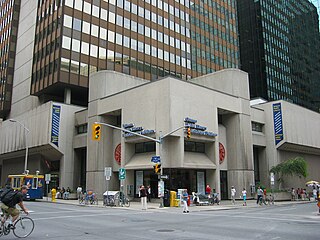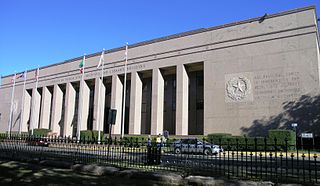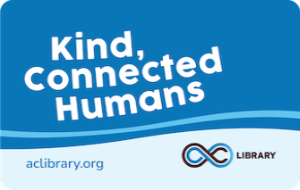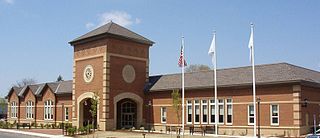Related Research Articles

A public library is a library that is accessible by the general public and is usually funded from public sources, such as taxes. It is operated by librarians and library paraprofessionals, who are also civil servants.

The Brooklyn Public Library (BPL) is the public library system of the New York City borough of Brooklyn. It is the sixteenth largest public library system in the United States by holding and the seventh by number of visitors. Like the two other public library systems in New York City, it is an independent nonprofit organization that is funded by the city and state governments, the federal government, and private donors. The library currently promotes itself as Bklyn Public Library.

The Ottawa Public Library is the library system of Ottawa, Ontario, Canada. The library was founded in 1906 with a donation from the Carnegie Foundation.

A bookmobile or mobile library is a vehicle designed for use as a library. They have been known by many names throughout history, including traveling library, library wagon, book wagon, book truck, library-on-wheels, and book auto service. Bookmobiles expand the reach of traditional libraries by transporting books to potential readers, providing library services to people in otherwise underserved locations and/or circumstances. Bookmobile services and materials, may be customized for the locations and populations served.

The Texas State Library and Archives Commission (TSLAC) refers to the agency in the state of Texas that assists the people of Texas to effectively use information, archival resources, public records and library materials to improve their lives, the lives of their families, and their communities. The agency is charged with overseeing statewide library programs, meeting the reading-related needs of Texans with disabilities, and preserving and providing access to significant Texas documents.

The Jacksonville Public Library is the public library system of Jacksonville, Florida. It primarily serves Jacksonville and Duval County, and is also used by the neighboring Baker, Nassau, Clay, and St. Johns Counties. It is one of the largest library systems in Florida, with a collection of over three million items. A division of the city government, the library has the third largest group of city employees after the city's Fire Department and Sheriff's Office. There are twenty branches and a Main Library in the system.

The Lethbridge Public Library is a public library service that is provided by the municipality of Lethbridge, Alberta, Canada. It was established in 1919. While it has had as many as three branches at one time, the library currently has two branches.

The Fullerton Public Library (FPL), is a public library system that serves the City of Fullerton, California and its surrounding communities.

Virginia Beach Public Library (VBPL), located in Virginia Beach, Virginia is a comprehensive library system serving Virginia Beach, an independent city with a population of 450,000 in the Hampton Roads metropolitan area of Virginia. The library supports the educational and leisure needs of citizens with a system of area libraries, a bookmobile, a virtual library, the Wahab Public Law Library, the Municipal Reference Library, and the Library and Resource Center for the Blind and Visually Impaired (DBVI). The collection contains more than 1 million print and non-print items.

The Alameda County Library, in Alameda County, California, is a public library system that provides services from ten branch libraries in the cities of Albany, Dublin, Fremont, Newark and Union City and the unincorporated communities of Castro Valley and San Lorenzo. According to 2005/2006 statistics, the total service area represents a population of about 522,000, and annual circulation is reported to be around 5.5 million. Its headquarters are located in Fremont.

The Mobile Public Library is a public library system primarily serving Mobile County, Alabama. The system is a department of the city of Mobile and receives funding from Mobile County and the city of Saraland.

The Chicopee Public Library is the public library for the city of Chicopee, Massachusetts. A member of the Western Massachusetts Regional Library System (WMRLS), the library participates in resources sharing and collaboration with all other libraries in the WRMLS. The library owns approximately 109,000 books according to the 2005 IMLS Public Library Report. In addition, they have 4,200 media items and send and receive over 35,000 interlibrary loan requests. In the fiscal year 2008, the city of Chicopee spent 1.1% of its budget ($1,401,141) on its public library, around $25 per person.

The Palm Beach County Library System is the public library system of Palm Beach County, Florida. Its headquarters, the Main Library, is located in an unincorporated area near West Palm Beach, the county seat. The system was established in 1967 and serves Palm Beach County through the Main Library and 17 branch libraries. Its first library branch opened in Tequesta on September 25, 1969 and its first bookmobile five days later. Unlike neighboring Broward and Miami-Dade counties, where most municipalities have joined their county's library system, most municipalities in Palm Beach County continue to operate their own city libraries, leading the county system to focus on the more suburban communities. Instead, a cooperative system model is in place to allow interoperation between county and municipal libraries.
St. Johns County Public Library System serves the surrounding areas of St. Johns County, Florida, including St. Augustine, Ponte Vedra Beach, Fruit Cove, and Hastings. The library system has six branches, two bookmobiles, and offers books-by-mail service. In addition to books, periodicals, and online databases, SJCPLS offers computer access, notary services, Inter-Library Loan service, access to a Seed Library, test proctoring, and many volunteer opportunities. The library system also offers a dynamic range of programming for adults, teens, and children.
Atlantic County Library System is the county library system of Atlantic County, New Jersey. The library system is the information center in Atlantic County. The Library System includes nine branch libraries located throughout Atlantic County: Brigantine, Egg Harbor City, Egg Harbor Township, Galloway Township, Hammonton, Mays Landing, Pleasantville, Somers Point, and Ventnor. The computerized public access catalog contains over 500,000 books, audio-visual and downloadable items. Atlantic County Library System also has a bookmobile, books-by-mail, and other outreach services.
The Tampa–Hillsborough County Public Library System (THPL) is a public library system based in Hillsborough County, Florida. THPL is part of two larger library networks, the Tampa Bay Library Consortium, and the Hillsborough County Public Library Cooperative which includes Temple Terrace Public Library in Temple Terrace, Florida, and Bruton Memorial Library in Plant City, Florida. There are 25 branches of the Tampa–Hillsborough County Library System, not including digital-only and mobile-only services. Services provided by the THPL include internet access, public meeting room spaces, interlibrary loans, a Bookmobile, a Cybermobile for Spanish speakers, technology classes, adult literacy programs, and downloadable eBooks. Drive-thru windows for returns and hold pick-ups are located at the Jimmie B. Keel and the Jan Kaminis Platt Regional Libraries. In 2017, THPL introduced the new HAAL Pass, which gives access to certain library resources to all students in the Hillsborough County Public Schools System. Students use their student ID number to use different online databases, borrow up to three physical items and read eBooks. The Tampa–Hillsborough County Public Library System is also a part of Hillsborough County government. On January 1, 2018 the library cooperative became one of the largest in the country to go fine free. Overdue fees for borrowed materials were eliminated with the implementation of the "Just Bring It Back" initiative. In 2019 the cooperative received the FLA Library of the Year Award. Tampa-Hillsborough County Public Library was recognized for its community focused initiatives when it "reorganized its staffing model and eliminated overdue fines, yielding $1 million in savings while increasing access to library resources and expanding opportunities for community engagement through unique, scalable programs.

The Utah State Library in Salt Lake City, Utah is a division of the Utah Department of Heritage and Arts.
Central Rappahannock Regional Library (CRRL) is a public library system that serves the city of Fredericksburg and Spotsylvania, Stafford, and Westmoreland counties in Virginia. The library system is within Region 5 of Virginia Library Association (VLA).

The Library Services Act (LSA) was passed by the U.S. Congress in 1956. Its purpose was to promote the development of public libraries in rural areas through federal funding. It was passed by the 84th U.S. Congressional session as the H.R. 2840 bill, which the 34th President of the United States Dwight D. Eisenhower signed into law on June 19, 1956. Julia Wright Merrill, Secretary of the Public Library Extension Committee of the American Library Association, was instrumental in the legislative process.
The Oxnard Public Library is a free public library system operated by the City of Oxnard, California. It has three locations: the Downtown Main Library, the South Oxnard Branch Library, and the Colonia Branch Library.
References
- ↑ "Western Massachusetts Regional Library System – Special Collections and University Archives". scua.library.umass.edu. Retrieved 2017-08-09.